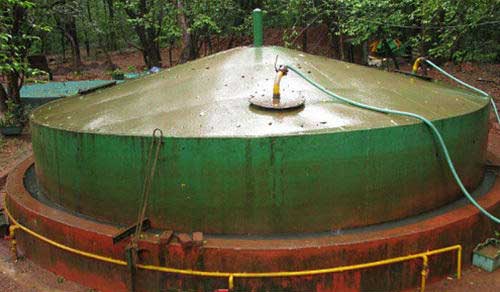
Biogas plant means a plant in which materials of animal cause are at least part of the material which is give in to to biological degradation under anaerobic conditions for the production of biogas.Biogas plant provides the biogas/ biofuel which is derived from the natural process of anaerobic decomposition, which happens in the nonappearance of oxygen. When the organic matter decomposed, a mixture of gases is released, primarily methane and carbon dioxide. Food wastes, animal dung, wastewater, and crop remainder are some of the organic materials used for biogas.Methane, a biofuel with a deep blue flame that generates energy, makes up 50% to 70% of biogas. The energy from biogas is utilized to make power, bio-methane (which is used as automobile fuel), and the digestion byproduct is used as fertilizer.
1. Domestic Bio Gas Plant
2. Gober Gas Plant
3. Anaerobic - Digester
A Good Alternative for Electricity and Cooking in Rural Areas and Developing Countries: Some areas have limited access to electricity, blocking their way of living. Biogas can provide them a good alternative. Both small- and large-scale production are feasible and easy to set up.
Produces a Circular Economy: Animal dung, food wastes, wastewater, and crop remainder are wastes produced by humans and animals. These wastes can cause harm if not process appropriately. By turning these organic wastes into biogas, the wastes are altered into a more useful way. The wastes are converted into biogas for use as fuel for vehicles and heating, natural gas for use in cooking and heating, and digestive acids for use as fertilizers.
Renewable Source of Energy: Plants, animals, and people all produce organic stuff. Biogas is a renewable energy source since raw materials are easily reproducible. It also lessens the harmful impact and inappropriate wastes disposal.
Utilization of Waste: Using the trash and converting them into biogas is preferable to letting them degrade in landfills. An environmental exposure is reduced due to lesser methane, carbon dioxide, and other greenhouse gases produced. Wastes are converted into energy that can be used for cooking, heating, electricity, and fertilizer.
Organic input materials such as foodstuff leftovers, fats or mud can be fed into the biogas plant as substrate.
Both the microorganisms in the biogas plant and animals like cows and pigs are fed on renewable resources like corn, beets, or grass. Dung is also served into the biogas plant.
The substrate in the fermenter, which has been heated to about 38–40 °C, is broken down by the microorganisms without the presence of light or oxygen. Methane is the primary component of the biogas produced by this fermentation process. Yet the biogas also includes abrasive hydrogen sulphide. The advantage of a stainless steel fermenter is obvious: it can survive attacks from hydrogen sulphide and last for many years. The biogas plant can also be operated in the thermophile temperature range (up to 56 °C) thanks to a stainless steel fermenter. Once the substrate has fermented, it is moved to the storage tank for fermentation byproducts, where it can be collected and used in other ways.
Remaining materials can be used to make high-quality fertilizer. The benefit: Because biogas manure is less sticky, it goes into the soil more quickly. Moreover, the fermentation residue frequently has a higher fertilizer value and is less overpowering to the sense of smell.
The tank's roof is used to hold the biogas before it is burned in the combined heat and power (CHP) plant to produce electricity and heat. The electric power is served directly into the power grid.
The heat produced can be used to dry wood, heat buildings, or harvest items. Processing of biogas. fueling stations or the national grid with gas